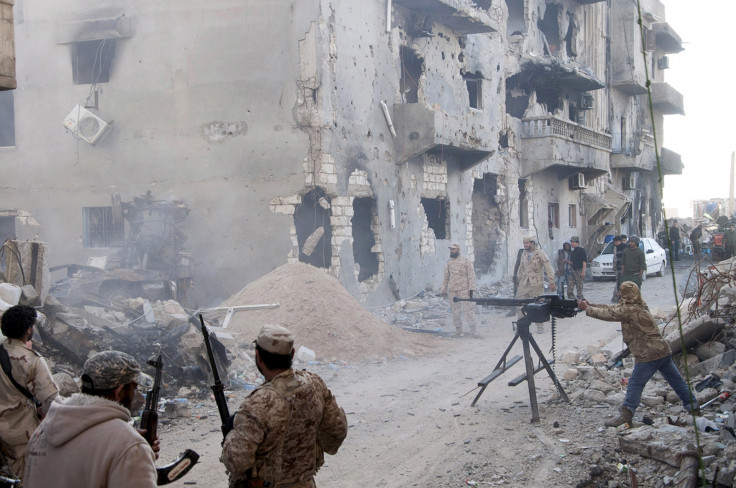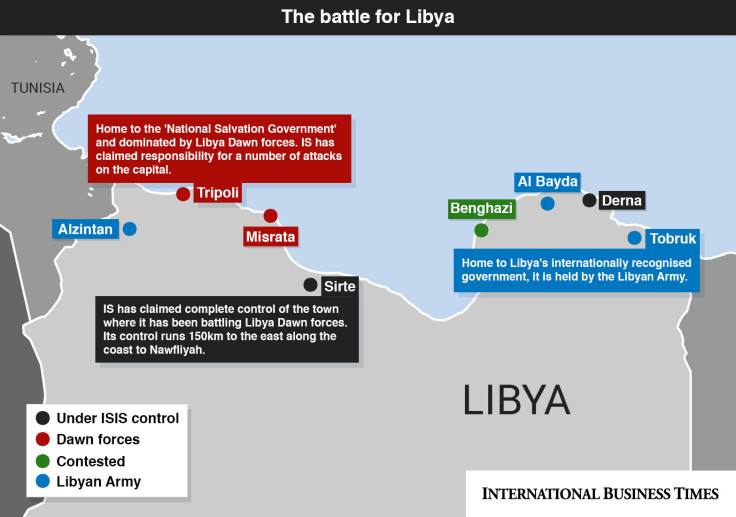Battle for Libya: A guide to the country's factions and militias

Since its 2011 revolutionary war Libya has spiralled into increasing lawlessness and violence as armed groups, remnants of the Nato-backed military action against the country's 42-year ruler Muammar Gaddafi, battle for control of the country.
Over the past year the majority of Libya's militias have begun to align themselves to one of two groups, either in support of the country's internationally recognised government or in support of an Islamist-leaning government of 'National Salvation' in Tripoli.
As the stalemate between the two opposed governments becomes evermore entrenched, two offshoots of Islamic State (Isis) in Libya – IS in Tripoli and IS in Cyrenaica – have capitalised on the political vacuum.
Islamic State has also benefited from the decline of Libya's more established powers like Ansar Al-Sharia and Abu Salim Martyrs Brigade, both linked to al-Qaeda.
Despite these three defined groups, the Libyan conflict has regional, tribal and ideological dimensions and can be viewed as a number of localised conflicts.
This IBTimes UK guide breaks down the largest factions and gives a brief outline of the major players in the Libyan conflict.
Internationally recognised government in Tobruk
Libya's internationally recognised government is headed by Prime Minister Abdullah Al-Thinni who has held that office since March 2014. The government and the elected House of Representatives which backs it was forced out of Tripoli in August when the capital was overrun by Islamist leaning militias. Since then it has operated out of Tobruk in the far east of the country, one of the last towns held by the Libyan Army.

Government of 'National Salvation' in Tripoli
The rival government to Tobruk assumed office in September last year after a loose coalition of militias united under the banner of Libya Dawn and took control of Tripoli. Comprised principally of Islamist politicians who lost their seats in June elections to the House of Representatives, the 'National Salvation' government claims its authority from Libya's General National Congress, the country's previous legislative body which was dominated by the Muslim Brotherhood but was set to be replaced by the more liberal House of Representatives.
Libyan Army
The Libyan Army is a rough amalgamation of battalions and brigades which defected from Muammar Gaddafi, revolutionary militias which joined its ranks and new recruits trained abroad. They are commanded by divisive former Gaddafi General Khalifa Haftar who led a splinter military group under the banner 'Operation Dignity' in a bid to rid eastern Libya of powerful Islamist militias. He was widely condemned at the time and accused of plotting a coup. However, Haftar and his forces were reabsorbed into the army by Thinni and the House of Representatives in March. In the west of the country brigades from the mountain town of Zintan fight against Libya Dawn under the auspices of the Libyan Army.
Libya Dawn
Libya Dawn, or Fajr Libya, is a coalition of militias principally from Misrata but also from Tripoli, Zawiya, Zuwarah and Gharyan. They see themselves as the inheritors of the 2011 revolution and banded together in 2014 after the Muslim Brotherhood was defeated in legislative elections. Misrata, from which most of Libya Dawn originates, endured the worst violence of the 2011 war against Gaddafi and emerged as one of the most powerful military forces in Libya following the revolution. Libya Dawn and the Misrata Revolutionary Council battle against Islamic State to the east and Libyan Army brigades to the west.

Islamic State
The offshoot of Islamic State in Libya is the most recent major force to exert its power in the country. The first Islamist brigade to formally pledge its allegiance to Abu Bakr Al-Baghdadi was the Shura Council of Islamic Youth in Derna, in June last year. Islamic State has taken control of most of Derna and is in the ascendency in Sirte where it claims to have taken complete control, following victories at the Qardabiya air base and the town's power station. Islamic State in Sirte operates under the banner of the Islamic State province of Tripoli and its influence extents from Sirte some 150km to the east, along the coastal road to the town of Nawfliyah. The militant group has also expanded its influence into Benghazi at the expense of Ansar Al-Sharia.
Ansar Al-Sharia
The rise of Islamic State in Libya has been at the expense of the al-Qaeda-inspired Ansar Al-Sharia which previously held the balance of power in Libya's second city of Benghazi. The group is classified as a terrorist organisation by the US and UN and is believed to be responsible for the US consulate attack which killed US Ambassador Chris Stevens in 2012. It is still powerful in Benghazi where it fights alongside Islamic State and it also has presence in Derna.
Abu Salim Martyrs Brigade
Much like Ansar Al-Sharia, Abu Salim Martyrs Brigade, named after one of the worst atrocities committed by Muammar Gaddafi in against inmates at Abu Salim prison, has diminished with the advent of Islamic State. Before the arrival of the offshoot in Libya the al-Qaeda linked group was the dominant force in Derna.The brigade comprises of a number of Libya's stalwart Islamist militants from the Libya Islamic Fighting Group which engaged in clashes with Gaddafi forces during the 1990s and made a failed assassination attempt on the former leader in 1996. Two senior figureheads in Abu Salim Martyrs Brigade were killed recently in an ongoing power struggle with Islamic State in Derna.

© Copyright IBTimes 2024. All rights reserved.






